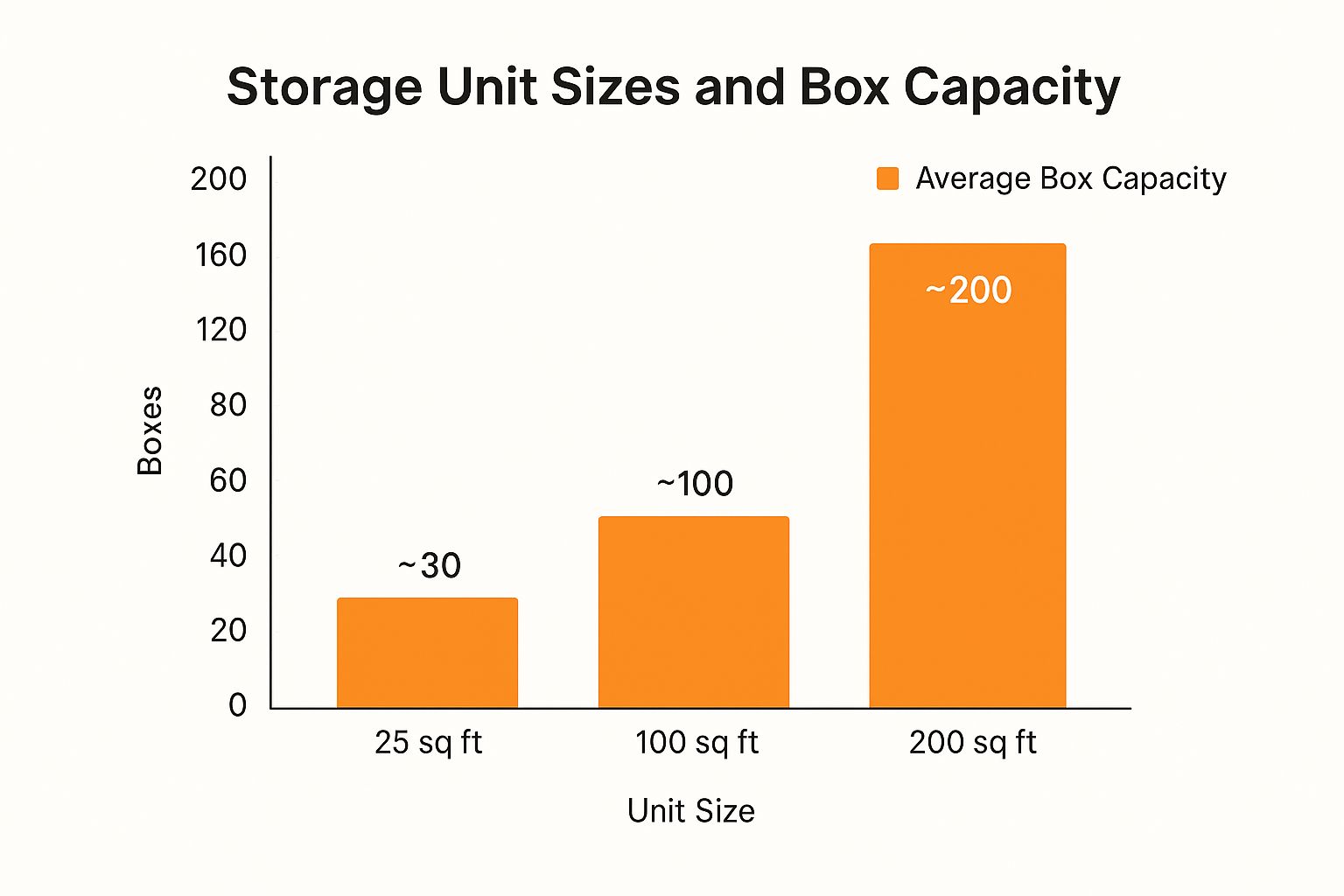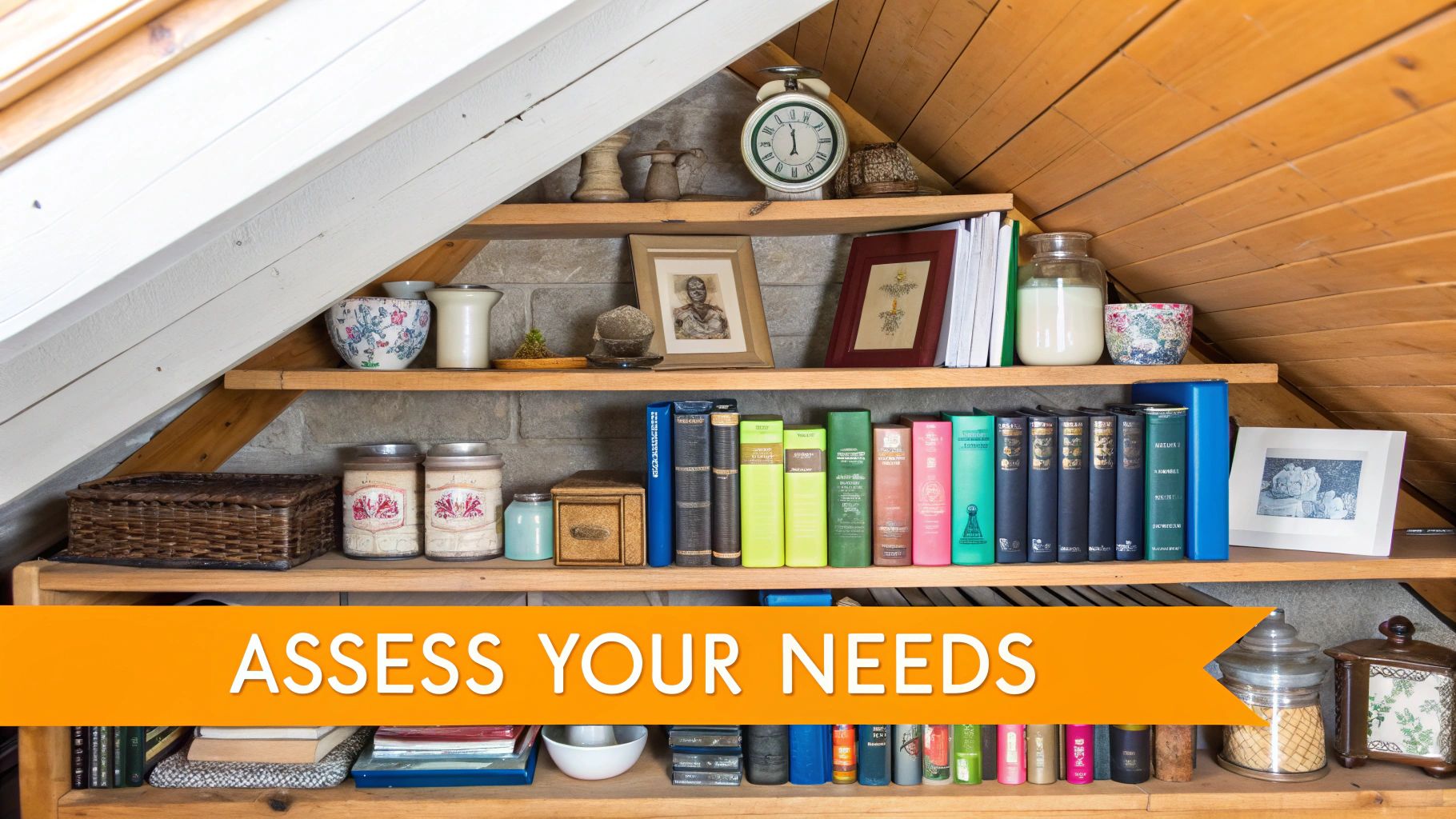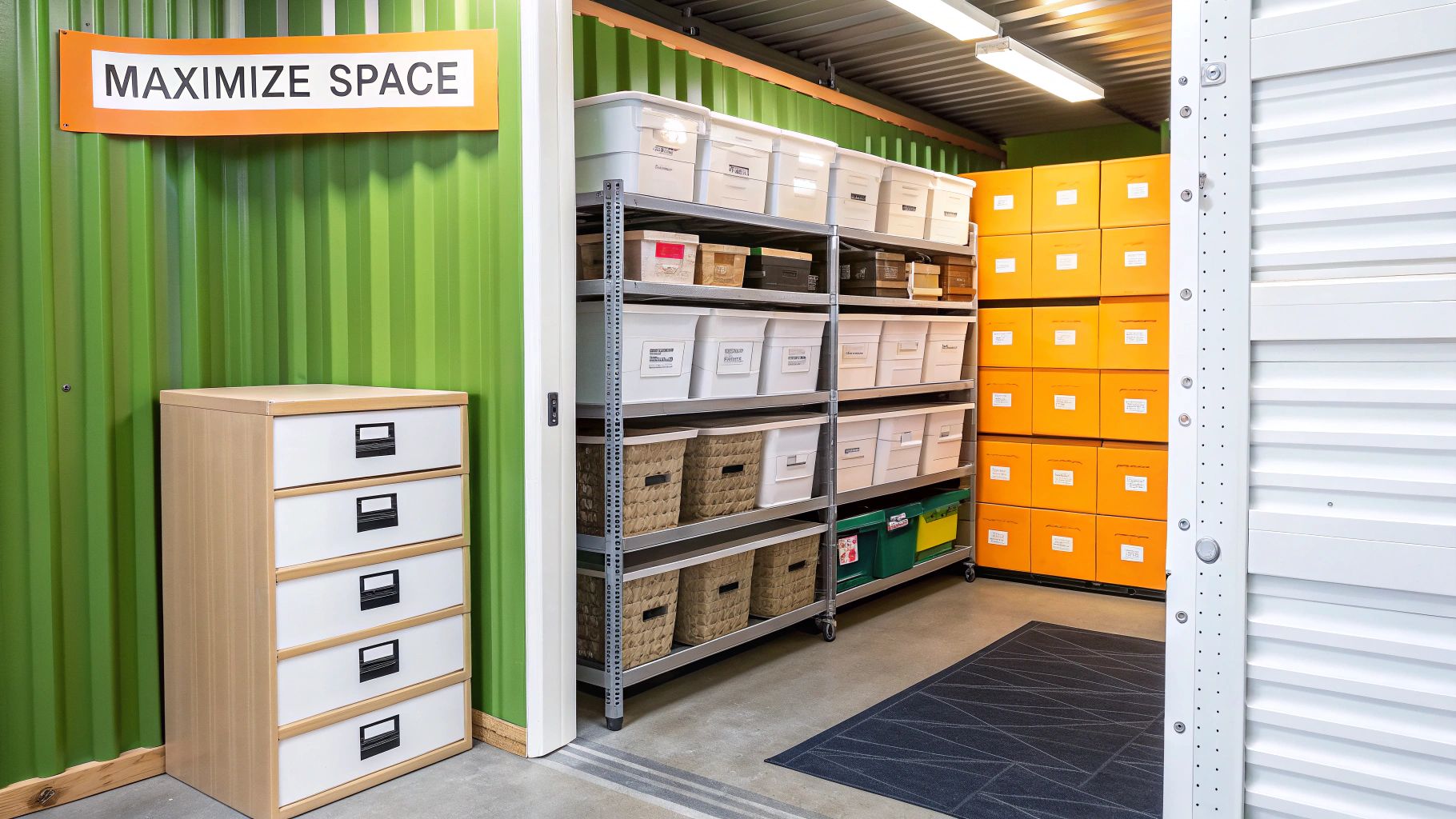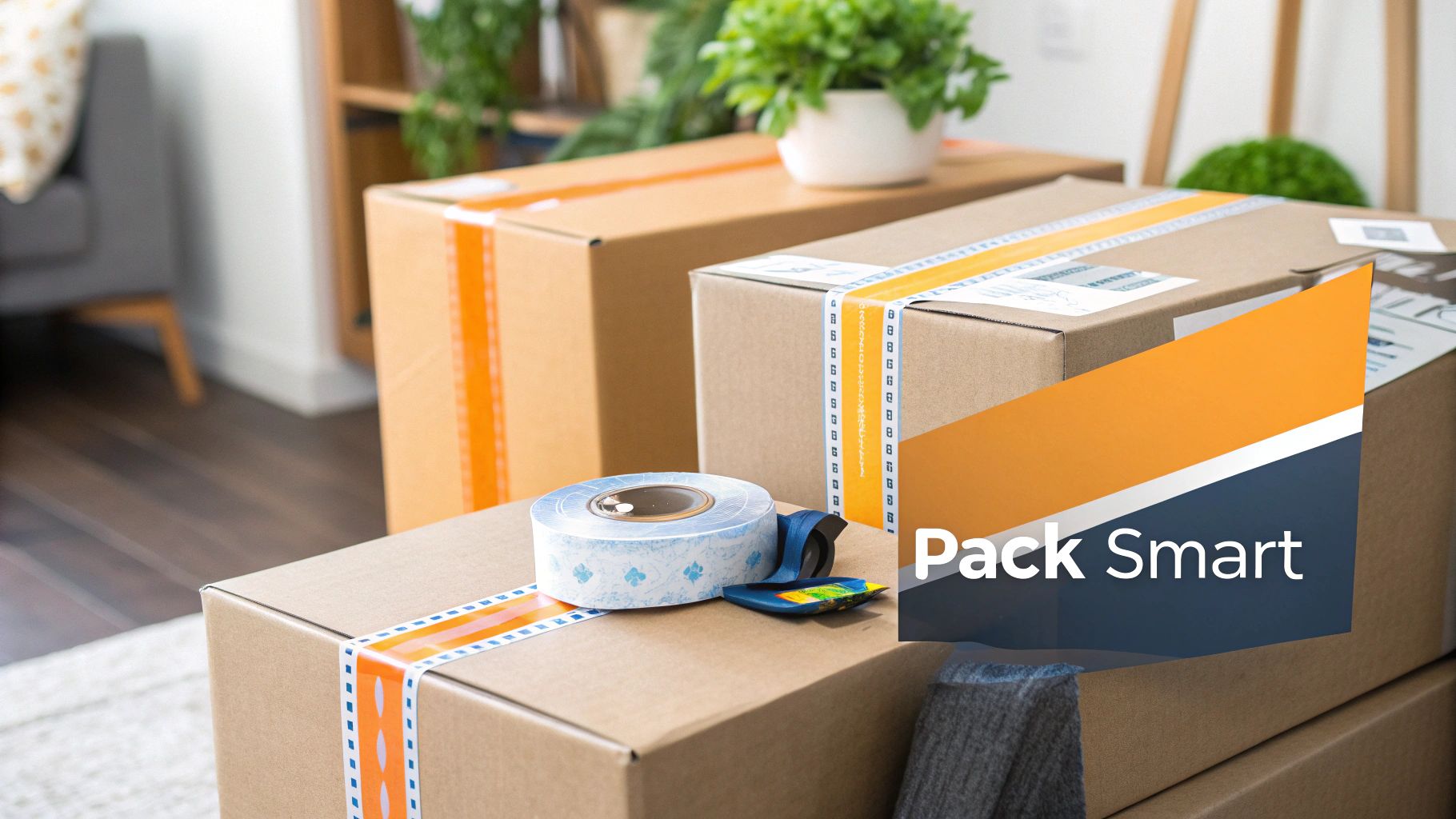Choosing the right storage unit is a bit like picking the right moving van. If you go too small, you're in for a world of frustration. Go too big, and you're just paying to store air. This self storage unit size guide is here to take the guesswork out of the equation.
Why Finding the Right Storage Unit Size Matters
Staring at a list of storage unit dimensions—5×5, 10×10, 10×20—can feel like trying to solve a puzzle without the picture on the box. Think of this guide as that picture. It gives you clear, real-world comparisons to help you visualise exactly how your things will fit into each space.
Getting the size right isn't just about cramming everything in; it's about being smart with your money and protecting your belongings.
A unit that’s just right means you're not overpaying, and your items are safe from the damage that comes from being squashed together. Key benefits include:
- Cost Savings: Why pay for space you don't need? Renting only what you require keeps your monthly bill down.
- Item Protection: Proper space allows for better stacking and prevents things from getting crushed, bent, or broken.
- Better Accessibility: A well-chosen unit lets you create a small walkway, so you can actually get to the things at the back without unloading everything first.
- Reduced Stress: Knowing your stuff will fit comfortably is one less thing to worry about during a move or decluttering project.
Visualising Your Space Needs
The easiest way to make sense of storage sizes is to compare them to spaces you already know. A small 25 sq ft unit, for instance, is roughly the size of a large walk-in wardrobe—perfect for the contents of a cluttered spare room. A medium 100 sq ft unit is a lot like a single garage, big enough for the contents of a two-bedroom flat.
One of the most common mistakes people make is underestimating how much room the small stuff takes up. Dozens of boxes, lamps, and other odds and ends can easily fill as much space as a big sofa. You have to account for everything, not just the bulky furniture.
This chart below gives you a quick visual on how many standard moving boxes you can expect to fit into the most popular unit sizes.
As you can see, the capacity scales up quickly. If you want a more personalised estimate, you can check out our guide on how much storage space you might need for a more precise calculation.
From Lockers to Wardrobes: A Guide to Small Storage Units
When you're looking at a self storage size guide, it’s all too easy to let your eyes skim past the smaller options. But underestimating the power of a compact space is a common mistake. For a whole host of situations, small units from 10 sq ft to 35 sq ft aren’t just enough—they’re the smartest, most cost-effective choice you can make.
Think of these smaller units as the precision tools of the storage world. You wouldn't use a sledgehammer to hang a picture, would you? In the same way, you don't need a double garage-sized unit for a few dozen boxes. Let’s break down what these mighty-but-mini spaces can actually hold.
The 10 sq ft Unit: Your Personal Telephone Box
The 10 sq ft (around 0.9 sq m) unit is usually the smallest you'll find, and it's surprisingly versatile. To get a feel for its size, just picture a classic red telephone box. It’s a tall, narrow space that’s absolutely perfect for stacking things vertically.
This size is a real favourite among students needing somewhere to stash their belongings over the summer holidays. It's also brilliant for anyone looking to archive important business documents without cluttering up the office.
What fits in a 10 sq ft unit?
- Up to 20 medium-sized archive boxes.
- A student's essentials: desk chair, small luggage, boxes of books, and a computer monitor.
- Hobby equipment, like all your camping gear or a few guitars in their cases.
- Everything you could cram into a large car boot.
The 25 sq ft Unit: Your Spare Walk-In Wardrobe
Stepping up to a 25 sq ft (approx. 2.3 sq m) unit gives you a lot more floor space—roughly the size of a generous walk-in wardrobe or a small garden shed. This is one of the most popular small sizes simply because it’s so versatile. It’s the perfect partner for a single-room decluttering project or for clearing out the spare room to make way for a nursery or home office.
Imagine you finally want to reclaim your guest bedroom from its current life as a dumping ground. A 25 sq ft unit can comfortably swallow the contents of that room, letting you reorganise without tripping over boxes.
This size is often the "just right" solution for seasonal storage. Think about all your Christmas decorations, garden furniture, and summer sports gear—a 25 sq ft unit can hold it all, freeing up precious space in your garage and loft.
What fits in a 25 sq ft unit?
- The contents of a studio flat (minus the big white goods).
- A double bed and mattress (stored on its side), a chest of drawers, and several boxes.
- Garden tools, a lawnmower, and patio furniture.
- Around 40-50 standard moving boxes if you pack them in smartly.
The 35 sq ft Unit: The Box Room Solution
The largest of our small units, the 35 sq ft (around 3.25 sq m) space, is about the size of a typical British box room or a large garden shed. This unit gives you that extra bit of breathing room for bulkier items or for the contents of a very cluttered single room.
It’s an excellent choice if you're storing everything from a packed shed, a study overflowing with books and files, or a child's bedroom. It can handle a mix of furniture and boxes, making it a flexible option for all sorts of small-scale storage needs. For a small business, it can even act as an archive room for files and marketing materials.
Picking the right option from a self storage unit size guide starts with an honest look at what you need to store. These smaller units prove you don't always need a huge space to get your home or office feeling clear and organised.
Taking a Look at Medium Storage Units: Perfect for Flats and Small Garages
Now we're getting into the real sweet spot of the self storage world. Once you move past the smaller options on a self storage unit size guide, you hit the medium-sized units, which usually run from 50 sq ft up to 80 sq ft. These are easily the most popular choice, and for a good reason: they offer incredible versatility for just about anyone, whether for personal or business use.
This is where storage stops being about just stashing a few extra boxes and starts becoming a solution to bigger life challenges. Got a flat move coming up? Need to clear out a room before a renovation? Maybe you need a place for your business inventory. These flexible spaces make all of that manageable. Let's get past the numbers and see what these units can actually handle in the real world.
The 50 sq ft Unit: The One-Bedroom Flat Mover's Best Friend
A 50 sq ft (around 4.6 sq m) unit is a true workhorse. To give you a better idea, picture a standard single-car garage and cut it in half—that’s roughly what you're working with. It’s more than enough room to comfortably store everything from an average one-bedroom flat.
For anyone who’s at the end of a tenancy or getting ready for a move, this unit is often the perfect match. You get enough space to hold all the essentials of modern life without wasting money on a room you don't need.
So, what really fits in a 50 sq ft unit?
- Living Room: A two-seater sofa, coffee table, TV stand, and a bookcase.
- Bedroom: A double bed with its mattress, a chest of drawers, and a couple of bedside tables.
- Kitchen: A small dining set, microwave, and other countertop appliances.
- Boxes: Around 80-100 standard moving boxes filled with clothes, books, and kitchen stuff.
This unit is the absolute go-to for anyone clearing a space for home renovations. If you're planning to redo the floors or paint a few rooms, a 50 sq ft unit keeps all your furniture safe from dust and damage, leaving you with a clear, stress-free workspace.
What makes this size so practical is how it bridges the gap between a small-scale declutter and a full-on house move. It's substantial enough to handle major life events but still feels affordable and easy to manage.
The 75 sq ft Unit: Your Own Personal Single Garage
Stepping up to a 75 sq ft (approx. 7 sq m) unit feels like having your very own single-car garage dedicated entirely to storage. That extra space makes a massive difference, giving you room for much bulkier items or the contents of a larger home, like a two-bedroom flat or a small house.
This is the size that really opens up your options. For families, it can hold furniture from multiple rooms plus all the garden equipment and outdoor toys. For a small business owner, it can act as a mini-warehouse for stock, marketing materials, or tools.
The versatility of units like these is exactly why self storage facilities across the UK offer such a wide range of sizes. Facilities can be anything from smaller rural sites with just 50 to 200 units, all the way up to huge, multi-storey urban centres with over 1,000 units. It ensures there's a perfect fit for every single need, from personal moves to complex business logistics. You can discover more insights about how UK storage facilities are structured to meet such diverse demands.
Common uses for a 75 sq ft unit:
- Moving Home: Easily swallows the contents of a two-bedroom flat. That includes big appliances like a washing machine and fridge-freezer, alongside all your furniture and boxes.
- Business Storage: An e-commerce business could store hundreds of products, plus all their packaging and shipping materials. It’s like having a small-scale fulfilment centre.
- Hobby and Collector Storage: This space is ideal for bigger toys like a motorbike, kayaks, or extensive camping gear. It's also great for a significant collection that’s outgrown the spare room.
- Downsizing: If you're moving to a smaller place, this unit can hold onto cherished furniture you're not ready to part with, buying you time to make decisions without the pressure.
When it comes down to it, choosing between a 50 sq ft and a 75 sq ft unit depends on a few key things. If you’re packing up a one-bedroom flat and don't mind taking larger furniture apart, the 50 sq ft will probably do the job. But if you have bulky items, stuff from a two-bedroom property, or need to leave an aisle so you can get to your things easily, the extra room in a 75 sq ft unit is definitely worth it.
Sizing Up Large Storage For House Moves and Businesses
When your storage needs go way beyond a quick declutter, you’re stepping into the world of large-scale units. This is the heavy-duty end of the storage world, designed for major life events like a full house move or for businesses needing some serious operational space. These units, usually starting from 100 sq ft and going up to over 200 sq ft, give you the sheer volume needed for big projects.
Forget trying to cram things in. These spaces are all about comfortably accommodating the contents of a three or four-bedroom house, including all the bulky furniture, white goods, and dozens upon dozens of boxes. They're more than just a temporary holding bay; they're a strategic tool for managing big personal and professional changes.
The 100 sq ft Unit: The Three-Bedroom House Mover
Think of a 100 sq ft (approx. 9.3 sq m) unit as your own spacious single garage. This size is the go-to benchmark for anyone moving the entire contents of a typical three-bedroom house. It gives you enough floor space to store large furniture sets, major appliances, and a huge number of boxes without having to play a stressful game of Tetris.
This unit is the perfect ally during a complicated property chain, giving you a secure place to keep absolutely everything while you wait for completion day. It’s all about peace of mind, knowing your possessions are safe and sound.
What you can realistically fit inside a 100 sq ft unit:
- Furniture: Multiple sofas, armchairs, a large dining table with chairs, and bedroom furniture from three rooms (beds, wardrobes, chests of drawers).
- Appliances: A fridge-freezer, washing machine, dishwasher, and other large kitchen items.
- Outdoor Items: Garden furniture, a barbecue, and bicycles.
- Boxes: Well over 150 standard moving boxes, depending on how efficiently you stack them.
The 150 sq ft Unit: A Mini-Warehouse for Growing Businesses
Moving up to a 150 sq ft (around 14 sq m) unit is like renting a one-and-a-half-car garage. While it’s an excellent option for a large four-bedroom house move, this is where commercial uses really start to shine. For a growing e-commerce business, this space isn’t just storage; it’s a small-scale warehouse and fulfilment centre.
Imagine an online retailer who has outgrown their spare room. A 150 sq ft unit can hold thousands of units of stock, along with shelving for organisation, a packing station, and all the necessary shipping supplies. It offers a professional, scalable solution without the hefty commitment of a long-term commercial lease.
The 200+ sq ft Unit: The Ultimate Commercial Space
The largest units, often 200 sq ft (approx. 18.6 sq m) and above, are the equivalent of a standard double garage. These are the giants of the self storage world, offering immense capacity for the most demanding personal or business needs. They can comfortably swallow the contents of a five-bedroom house, including all the garden equipment and garage clutter.
For businesses, this is where things get serious. A tradesperson, like a builder or plumber, could use a 200 sq ft unit to store large equipment, tools, and bulk materials like pipes or timber. It acts as a secure and accessible depot that's far more cost-effective than renting a traditional industrial unit.
Self storage has transformed from a simple place to store personal effects into a dynamic commercial tool. Businesses now use these large units as flexible workshops, inventory hubs, and archival centres, allowing them to scale their operations affordably and efficiently.
This flexibility is a complete game-changer. Our guide on how businesses can use self storage explores these commercial applications in more detail, showing how companies are using these spaces for growth. Whether you’re planning a major house move or scaling a business, large units offer the space and potential to make big projects happen smoothly.
How to Pack Your Storage Unit Like a Pro
Choosing the right unit from a self-storage size guide is a great start, but the real win comes from smart packing. Getting your unit organised efficiently is a skill that makes the most of every square foot, keeps your belongings safe, and can even save you money by letting you use a smaller, cheaper space.
Think of it like a game of Tetris. The goal isn't just to cram things in; it's to create a dense, stable structure that you can still get to later. A well-packed unit means you won't have to pull everything out just to find one box at the back.
Master the Fundamentals of Smart Packing
A little prep work before you start loading will make a huge difference. First, make sure everything you’re storing is clean and completely dry to stop mould or mildew from taking hold over time. For certain items, this is a non-negotiable step. For example, if you plan on storing rugs, learning how to deep clean carpets at home first will keep them fresh and in great condition.
Next, get your packing supplies sorted. It’s tempting to grab free boxes from anywhere you can, but that’s often a recipe for disaster.
- Use Uniform Boxes: It’s worth investing in good-quality, sturdy boxes of similar sizes. They stack much more easily and create stable walls that are less likely to topple over.
- Label Everything: Seriously, everything. Mark each box on at least three sides (never just the top). Note the room it’s from ("Kitchen") and a quick summary of what’s inside ("Pots, Pans, Blender"). You'll thank yourself later.
- Don't Overpack: If you can't lift the box, it's not packed right. Keep the weight of each box manageable. A good rule of thumb is to put heavy items in smaller boxes and lighter, bulky things in the larger ones.
The Strategic Layout for Maximum Space
Once your boxes are ready, it's time to think about the layout inside the unit. The trick is to find the perfect balance between packing things in tightly and still being able to get to them.
The single most important element of an organised storage unit is a central walkway. Leaving a clear path down the middle allows you to access items at the back without having to dismantle your carefully built stacks of boxes.
Here’s a simple, step-by-step approach to loading your unit like a pro:
- Create a Map: Before you move a single thing, sketch a quick plan of where the big items and different box categories will go. Think of it as your blueprint.
- Heavy Items First: Place your largest, heaviest items—like appliances and solid furniture—along the back wall. This creates a solid base to build upon.
- Dismantle Furniture: Take apart what you can, like bed frames, tables, and shelves. Store them standing upright against the walls to save a surprising amount of floor space. Just remember to wrap legs and delicate bits to prevent scratches.
- Build Walls of Boxes: Stack your labelled boxes along the sides of the unit, creating firm walls. Put the heaviest boxes on the bottom and the lightest ones on top, always making sure the labels are facing your walkway.
- Leave Access: Anything you think you might need to grab—like seasonal decorations or important files—should be placed right near the front for easy access.
For a deeper dive, our complete guide on how to pack your storage unit is packed with even more expert tips to make the whole process a breeze.
Common Storage Mistakes and How to Avoid Them
Picking the right size is half the battle, but avoiding a few common slip-ups is what makes for a truly smooth storage experience. Before you book a unit, it’s worth thinking about specialty options that can make a huge difference in protecting your belongings.
For example, if you're storing valuable electronics, wooden furniture, or antiques, a climate-controlled unit is a must-have to prevent damage from the UK's unpredictable temperature swings. And for anyone wrestling with heavy items, a drive-up unit is a back-saver, letting you load and unload straight from your vehicle.
Making an informed choice helps you sidestep the little pitfalls that can turn storage into a headache. With the UK self storage market now valued at around £1 billion in 2024, more people are using these services than ever before, but simple errors can still be costly. If you're interested in the details, you can read the full research about the UK self storage market.
Underestimating How Much Space You Need
It’s the classic mistake: trying to save a few pounds by renting a unit that’s just a little too snug. This almost always ends in a frustrating game of Tetris, often leading to items getting damaged as they’re crammed in too tightly.
Solution: When in doubt, go one size up. The small extra cost is well worth the peace of mind. It also makes organising and accessing your items far easier down the line. Use an online calculator to get a good estimate, but always factor in a little extra room for a walkway.
Forgetting You Need to Access Your Items
So many people pack their unit like it's a time capsule, burying the things they might actually need at the very back. When you suddenly realise your winter coats are trapped behind a mountain of furniture, it's a bit too late.
Solution: Plan your layout before you start moving things in. Keep items you’re likely to need near the front and try to leave a clear aisle down the middle. This simple step transforms your unit from a chaotic pile into a well-organised, accessible space.
Ignoring the Importance of Insurance
It's a common assumption that home insurance automatically covers items in storage, but this is rarely the case. Without specific storage insurance, you have zero protection against theft, fire, or water damage.
Solution: Always get insurance. Reputable facilities will offer affordable policies, or you can check with your own provider for a specialised plan. It's a small price for total security and knowing your belongings are protected.
Packing Prohibited Items
For safety and hygiene reasons, every storage facility has a list of items you just can't store. Packing things like flammable liquids, perishable food, or living plants can lead to infestations, damage, and could even get your rental agreement terminated.
Solution: Before you pack, ask the facility for a list of restricted items and stick to it religiously. This simple check protects not only your belongings but also those of your neighbours, and ensures you stay on the right side of your contract.
Got a Few More Questions?
Even with a size guide handy, you'll probably have a few practical questions pop into your head. It’s completely normal. Let's run through some of the most common ones we hear, so you can feel confident you’re making the right choice from day one.
How High Are Most Storage Units?
Most self storage units here in the UK have a standard ceiling height of about 8 feet (which is roughly 2.4 metres). This vertical space is your secret weapon, but only if you use it smartly. The key is to always think vertically when you're packing.
Make your life easier by using sturdy boxes of the same size. They’ll stack neatly and safely without caving in. Just remember the golden rule: heaviest boxes at the bottom, lighter ones on top.
- Take apart furniture like bed frames and tables. You can store them upright against a wall to save a surprising amount of floor space.
- Sofas can often be stored on their end—it’s a classic trick for freeing up room.
- Think about bringing in some freestanding shelves (just check with the facility first). It’s a brilliant way to keep smaller items organised and stops you from having to unstack everything to get to that one box at the very bottom.
Should I Rent a Larger Unit Than I Think I Need?
It's a classic dilemma, isn't it? You don't want to waste money paying for empty space, but squeezing everything into a unit that’s too small is an even bigger headache. A good rule of thumb is to aim for a unit that will be around 80-90% full once all your stuff is inside.
This leaves you with that all-important "breathing room." More importantly, it gives you enough space for an aisle, so you can actually get to the items at the back without having to pull everything out first. If you're stuck between two sizes and the price difference isn't huge, going for the larger one is almost always the smarter move.
What's the Difference Between Indoor and Outdoor Units?
The main difference really boils down to two things: how you access them and how much they’re protected from the great British weather.
Indoor units are tucked away inside a larger building, usually down corridors. They offer much better protection from the elements and big temperature swings. This makes them the go-to choice for anything sensitive, like your electronics, wooden furniture, or important documents.
Outdoor units, which you'll often hear called "drive-up" units, are on the ground floor. They have a roll-up door you can drive your van or car right up to. For convenience, they can't be beaten, especially when you’re loading and unloading heavy, awkward items. They’re perfect for things like garden tools, business stock, or the contents of your garage where quick and easy access is what matters most.
Ready to find the perfect space for your needs? At Standby Self Storage, you can get instant pricing and book your secure unit online in minutes. Visit us at https://www.standbyselfstorage.co.uk to get started today.




